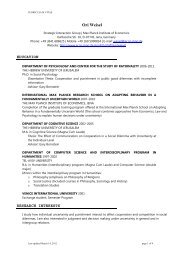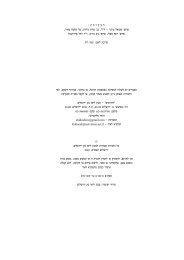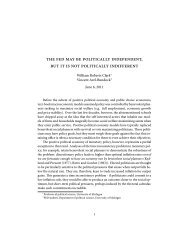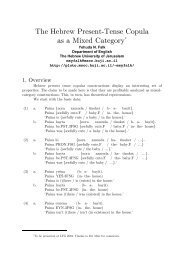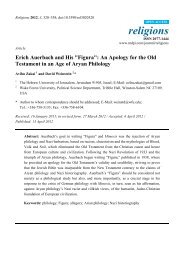Transitive verbs with non-accusative alternation in ... - Pluto Huji Ac Il
Transitive verbs with non-accusative alternation in ... - Pluto Huji Ac Il
Transitive verbs with non-accusative alternation in ... - Pluto Huji Ac Il
You also want an ePaper? Increase the reach of your titles
YUMPU automatically turns print PDFs into web optimized ePapers that Google loves.
88<br />
Rivka Halevy<br />
(59) ??hu’ nehelam biydey šoded<br />
he was-struck (on the head) by-hands(of) robber<br />
(60) ??hu’ hutslaf biydey 'adono<br />
he was-whipped by-hands(of) his-master<br />
In contrast, passivization characterizes <strong>verbs</strong> that do not imply a<br />
Manipulator. The verb hika ‘hit’ does not imply a Manipulator because one<br />
can hit somebody by direct “transfer of energy” from A to O; it can<br />
therefore be passivized, as shown <strong>in</strong> (61):<br />
(61) hu’ ‘amar še-huka kašot bi-zman ha-xaqira<br />
he said that-he-was-beaten severely dur<strong>in</strong>g the-<strong>in</strong>terrogation<br />
‘He said that he was severely beaten dur<strong>in</strong>g the <strong>in</strong>terrogation’<br />
The fact that passivization is excluded <strong>with</strong> hit <strong>verbs</strong> that do not exhibit a<br />
high degree of transitivity suggests that passivization obeys a constra<strong>in</strong>t on<br />
the aspect of the entire expression rather than directly on the Aktionsart of<br />
the verb alone.<br />
5.3. Summary<br />
The notions at stake <strong>in</strong> the ‘et/be- <strong>alternation</strong>, viz.<br />
‘motion’, ‘contact’, ‘causation’ and ‘change of state’, are also <strong>in</strong>volved <strong>in</strong><br />
the above discussed diathesis <strong>alternation</strong>s. The body-part possessor<br />
ascension <strong>alternation</strong> is sensitive to the notion of contact: it is available for<br />
contact by motion <strong>verbs</strong>, e.g. hika ‘hit’, and pure contact <strong>verbs</strong>, e.g.<br />
naga’ ‘touch’. The causative/<strong>in</strong>choative <strong>alternation</strong> is found only <strong>with</strong> pure<br />
change of state <strong>verbs</strong>, such as šavar ‘break’, but is excluded <strong>with</strong> transitive<br />
<strong>verbs</strong> that specify how the change of state occurs, i.e. <strong>verbs</strong> that refer to the<br />
realization of contact or to the actual process from <strong>with</strong><strong>in</strong>. The middlepassive<br />
<strong>alternation</strong> is found <strong>with</strong> <strong>verbs</strong> whose mean<strong>in</strong>g <strong>in</strong>volves caus<strong>in</strong>g a<br />
change of state, such as šavar ‘break’ and xatax ‘cut’, but is excluded <strong>with</strong><br />
<strong>verbs</strong> of contact by motion which does not <strong>in</strong>clude the change-of-state<br />
feature, such as hika ‘hit’. Passivization is excluded <strong>with</strong> hit <strong>verbs</strong> which do<br />
not entail direct transfer of energy from the A to the O but which <strong>in</strong>volve<br />
three semantic roles, two core participants and a Manipulator.<br />
The ‘et/be- <strong>alternation</strong>, for its part, is sensitive to both contact and<br />
motion, hence it is typically found <strong>with</strong> hit and cut <strong>verbs</strong> and their<br />
paradigmatic associates (Classes 1–6). The existence of l<strong>in</strong>ks between verb



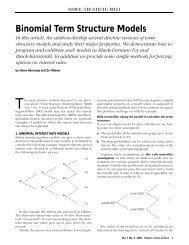
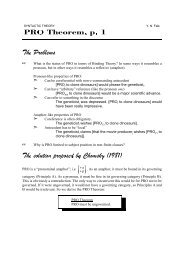
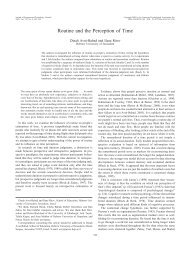
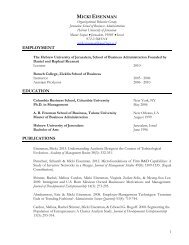
![CV [PDF] - Pluto Huji Ac Il](https://img.yumpu.com/18174585/1/190x245/cv-pdf-pluto-huji-ac-il.jpg?quality=85)

